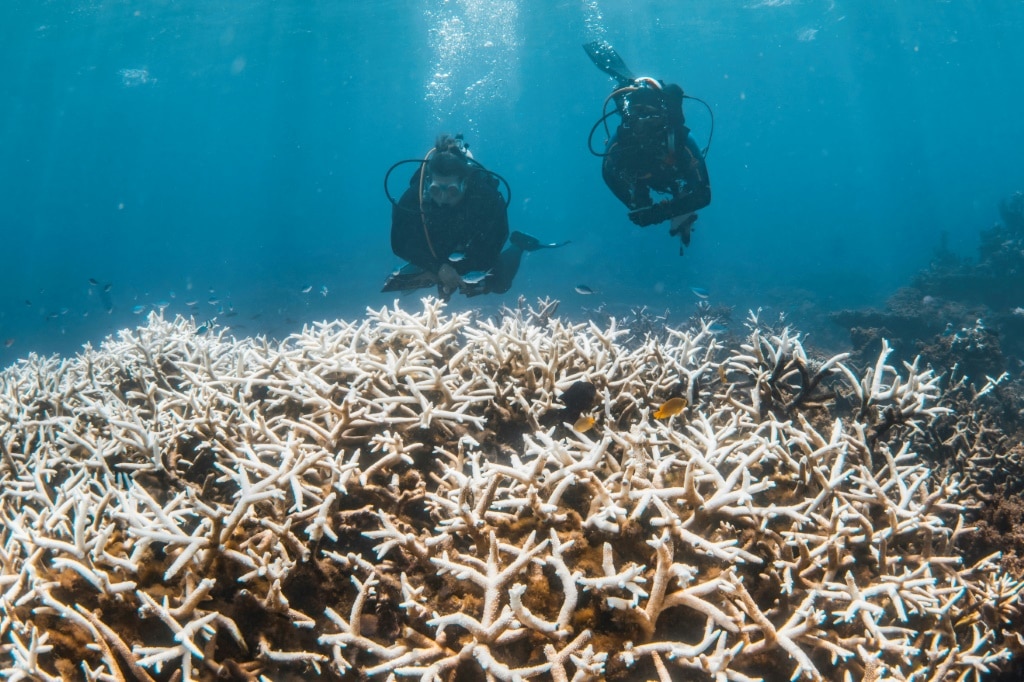Alarm as drones expose extent of dead coral in Great Barrier Reef
‘One of the highest coral mortality rates ever documented globally.’ Australian scientists have suggested diverse reasons for coral deaths on the Great Barrier Reef.

Marine biologists have deployed drones to document the world’s highest death rates of corals in the tropical waters off Lizard Island, on the Great Barrier Reef.
Researchers from three universities, the CSIRO and GeoNadir discovered that fewer than 10 per cent of corals survived last year’s mass coral bleaching event.
Bleaching damaged 96 per cent of corals analysed across 20 sections of the shallow northern and southern reefs of Lizard Island, with each section 10m by 10m square.
Previous studies have shown that at least half of corals can withstand bleaching, but the latest research shows that 92 per cent of the bleached corals off Lizard Island died within three months.
Lead author Vincent Raoult, from Griffith University’s School of Environment, said the coral died even though the waters were cooler than other parts of the Great Barrier Reef.
“This marks one of the highest coral mortality rates ever documented globally,’’ he said.
“Despite lower heat stress at Lizard Island compared with other parts of the Great Barrier Reef, the mortality rate is unprecedented.’’
Professor Jane Williamson, from the School of Natural Sciences at Macquarie University, said the findings showed the “urgent need for action on climate change’’.

The team used high-resolution drone imagery to map coral bleaching in March 2024, returning three months later to discover 96 per cent of corals had died.
In a research paper published in the scientific journal Coral Reefs, the research team noted that Lizard Island has experienced “multiple large-scale disturbances, including bleaching, cyclones, pollution and crown-of-thorns (starfish) outbreaks, whose effects have likely accumulated over time and diminished the corals’ capacity to recover’’.
Severe bleaching, along with cyclones in 2016 and 2017, had destroyed two-thirds of the coral – but the species that grew back in its place seemed more susceptible to bleaching.
“The dominant coral species in these sites could explain the higher mortality,’’ the research concluded in their research paper.
“Coral cover at Lizard Island at the start of 2024 was much higher than in early 2016.
“We note that most corals we observed in the survey areas were tabular Acropora spp. that rapidly grew across the area after previous bleaching, and it is possible the greater coverage of this (type) relative to previous years could explain higher mortality.
“The mortality rates we have measured are concerning given that cumulative heat stress at Lizard Island was not as high as other parts of the Great Barrier Reef, and was lower than during previous bleaching events occurring on this reef.’’
Dr Raoult told The Australian that the shallowness of the reefs off Lizard Island could be a factor in the high death rate of corals.
“Lizard Island had lower heat exposure than other reefs on the Great Barrier Reef, so there are either other factors at play – cumulative stress from previous bleaching, really stagnant water – and/or it suggests a lot of the reefs that didn’t get assessed like ours did are probably worse off,’’ he said.
The study was a collaboration between Macquarie University, Griffith University and James Cook University.
In separate research, RMIT University researchers have found that culling sea native urchins could restore the dwindling kelp forests in Melbourne’s Port Phillip Bay, while delivering $92m in economic benefits.
In a study published in Ecosystem Services, the researchers proposed that $50m be spent to pay commercial divers to cull sea urchins while cultivating kelp to restore the natural reefs.

Most of the $92m economic gain would come from restoring kelp forests to remove nitrogen from the bay, as well as boosts to recreational fishing and carbon storage to mitigate climate change.
The Victorian-government funded research was led by RMIT, collaborating with Deakin University, the University of Melbourne, University of Western Australia and Canopy Economics and Policy.






To join the conversation, please log in. Don't have an account? Register
Join the conversation, you are commenting as Logout